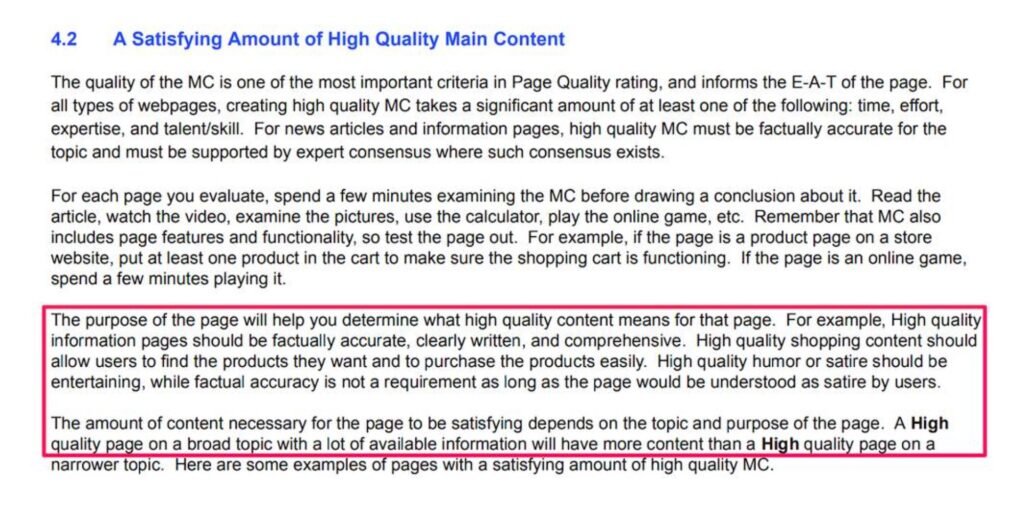When it comes to blogging, one of the most often asked questions is the appropriate length of a blog post for boosting SEO and user engagement. The optimal length of a blog post is influenced by various factors, including quality and user interaction. When determining the appropriate blog length for your posts, numerous factors must be considered, with varying lengths offering benefits and disadvantages depending on different factors.
According to the Google Guidelines, there are no strict requirements for a certain length of a blog post to rank high. Look at the screenshot from Google Search Quality Evaluator Guidelines.

Unfortunately, this information doesn’t bring much value to content marketing experts, who wish to get the most out of content and hit both goals: high rankings and engagement from readers.
But this article will look at how the length of a blog post influences SEO and the advantages and disadvantages of shorter vs. longer blog articles.
Let’s dive in.
What is the recommended length of a blog post for SEO?
According to research, each content you publish on your blog should be at least 300 words long to get ranked in search engine results. Research indicates that a minimum word count of 300 words is necessary for blog postings to be noticed and ranked by search engines. This is mostly because a blog post needs to include keyword research and other critical SEO optimization techniques in the text.
While 300 words are the suggested minimum, research indicates that articles with more than 1,000 words perform better in search engines for several reasons. More importantly, Forbes reports that longer blog posts were over 68 percent more likely to be shared on Twitter and over 22 percent more likely to be liked on Facebook. Longer blogs are more time-consuming to write, and visitors prefer shorter easier-to-digest content.
I understand that the suggested minimum isn’t what you’re looking for. So I’ve collected the statements from the most respectful sources of the data: according to Hubspot, the ideal blog post length should be around 2,100-2,400 words; Neil Patel suggests blog posts should vary between 1,100 and 2,700. And Backlinko stated that he’s found the most perfect answer – 1, 890 words. All the data above is giving you the answer that the ideal post length should be on average 2, 000 words.
But let’s dive deeper into the topic and consider both advantages and disadvantages of writing different types of content.
The Upsides of making shorter blog contents
1. It is more convenient to create material regularly.
Shorter content is far easier to generate consistently. Weekly 1,000+ word articles are not exactly practical for most people. Generating shorter material boosts your chances of developing and adhering to a blog publishing schedule.
2. A shorter blog article is usually simpler to read.
Additionally, shorter information is typically more readable, especially if you are not a skilled writer. This is because many writers cut corners when producing long-form content, which worsens your SEO and defies the purpose of longer content in the first place. On the other hand, if you are not a competent writer, you should normally stick to shorter, more reader-friendly pieces.
3. With concise material, you can get to the point quickly and effectively communicate your message.
Longer material does not always imply higher quality.
Posting shorter content enables you to publish more of it and cover a wider variety of topics. Rather than spending hours researching and writing the ”perfect article” on just one of your organization’s many characteristics, creating short, snappy blogs on various topics relating to your organization will enable you to reach more readers and educate them on a larger range of concerns.
Apart from the benefits mentioned, shorter information has been shown to promote a product or service or encourage a reader to take a certain action. If you want a reader to take action, such as clicking on a call to action, downloading a new e-book, or subscribing to an email list, a concise, to-the-point blog post is generally sufficient. As a result, you can share your message better and add value to email communication as well.
The downsides of writing shorter blog contents
1. Because search engines are robotic, they may fail to grasp the context of your page’s content.
The primary downside is that shorter posts don’t rank and longer pieces of content in search engines. With fewer words, there are fewer keyword ranking alternatives. This ranking gap is caused by various factors, all of which seem to lead to the idea that more material equals more potential to optimize your content for better search engine results, while less content does the opposite.
2. The material may be too brief, content may not be able to communicate properly with readers.
Readers are looking for a comprehensive answer to their search questions. Obviously, a short material may not be able to cover the needs of the users. Here it’s important to work on intent-based marketing.
The advantages of creating longer blog content
There are numerous significant reasons you should create lengthier blog posts, as long as the quality is not compromised.
1. Readers are more inclined to spend more time on your page.
According to Medium’s study, the best length for blog articles is 1,600 words, which helps search engines better grasp the context and meaning of your material (or seven minutes of reading). This SEO number Readable content is based on examining the “average total seconds spent on each article and compared to the post length.” According to their findings, readers’ average time spent looking at the post grew up to the seven-minute/1,600-word threshold before staying stable for a while and rapidly falling beyond that point.
2. More engagement
Additionally, longer content is more likely to be shared on social media and linked to other blogs, both of which benefit your SEO.
The disadvantages of creating longer blog content
While lengthy material offers a plethora of benefits, it also has downsides.
1. Lengthy content often tends to bore readers.
Keeping readers completely engaged is one of the most challenging issues writers have when producing long content. According to statistics, the average reader reads roughly 25% of a blog post, which implies they are most likely skimming the bulk of your longer pieces. We recommend that you include visuals like photographs, infographics, charts, and GIFs to capture your reader’s attention and keep them reading until the finish.
2. It requires more advanced writing skills
Another disadvantage of lengthy material is that it requires superior writing abilities. If writing is not your strong suit, you may lack the confidence necessary to create high-quality blog content that exceeds 1,000 words in length.
Conclusion
So, how long should a blog article be?
Both shorter and longer blog posts offer several pros and downsides, and each may have a different effect on your SEO.
Shorter content (at least 300 words) is the appropriate blog post length for you to publish regular material on a broad range of themes that motivate readers to take action. Aim for a minimum of 500 words on each page to avoid duplicate material appearing in Google and other search engines.
However, if you want to develop a piece of content that will significantly improve your SEO and user engagement, you might consider devoting some additional time to writing excellent, long-form content of 1,500+ words. Less frequent postings with more context will triumph in the SEO game.
The bottom line, remember that the most crucial aspect of each blog article is to balance the reader’s time successfully, the value supplied, and the search engine context. If you can consistently strike a balance between these three elements, you will have a high-ranking site that your readers like.
Author Bio
Julia Burova: Julia is a professional strategic marketer. She helps small businesses to develop brand awareness and attract the right audience. Currently, Julia works at Workee – back office for freelancers.
